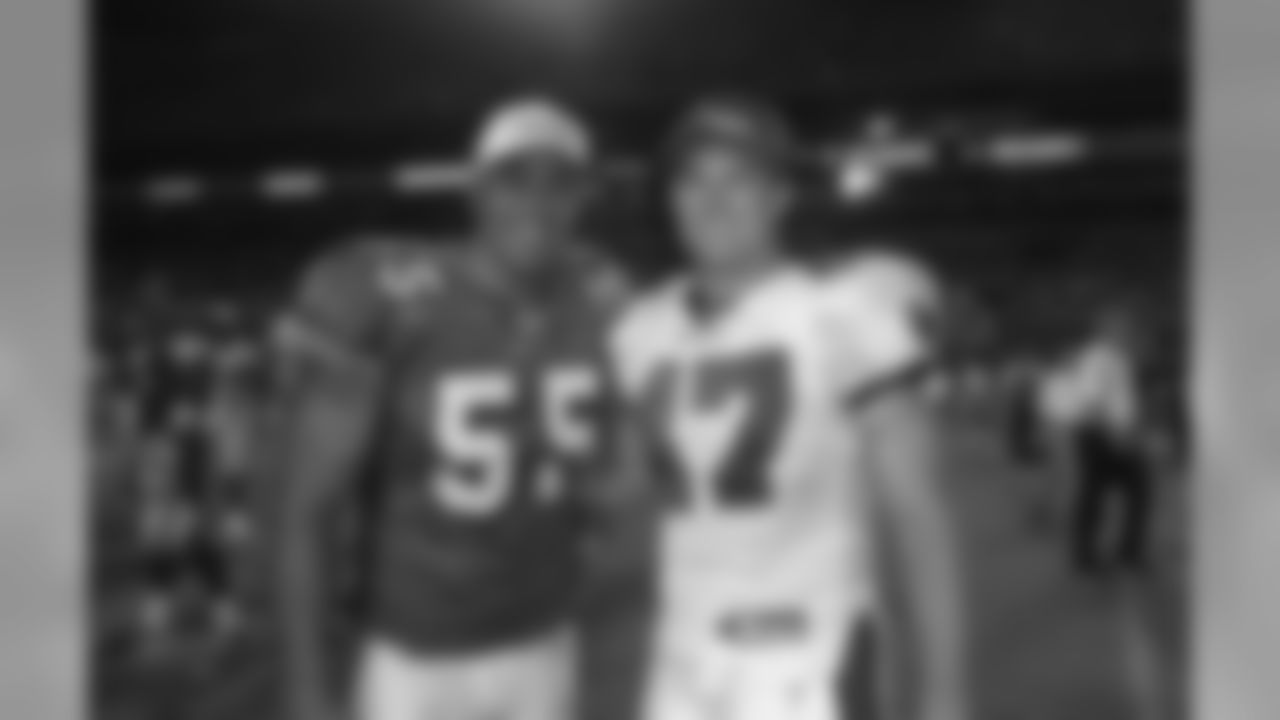[

](http://www.buccaneers.com/news/article-graphics/INFOGRAPHIC-John-Lynch/9394c279-825b-45a6-9fb7-0f76577632b9)
RELATED LINKS
> 5 picks that exceeded value
> Today in history: Champs!
> Senior Bowl standouts
> Senior Bowl preview
> NFC South this week
> Senior Bowl: Top 20 recruits
> 8 controversial moments
> Senior Bowl videos, day 3
> Q&A: Patrick Murray
> Mailbag: #1 pick value
This Saturday, the 46-member Selection Committee will meet behind closed doors to pare a list of 15 modern-era finalists down to a maximum of five and form the Pro Football Hall of Fame's Class of 2015. Among those 15 finalists are two prominent former Buccaneers, John Lynch and Tony Dungy. We'll discuss Dungy's candidacy later this week, but first let's cut to the chase on one of the greatest players ever to don a Tampa Bay uniform:
John Lynch should be in the Hall of Fame.
Those 46 committee members will discuss, among other things, the overall impact that each of the finalists had on the NFL. And, as it happens, there is no better single word to sum up Lynch's career than "impact."
Hundreds of opposing receivers and running backs felt that impact during Lynch's 15-year run and most of them remember it to this day, as he was a legendarily fierce hitter. There's a reason that Lynch has been identified as one of the top 10 "most feared tacklers" in NFL history, rubbing shoulders with the likes of Dick Butkus, Ray Lewis and Ronnie Lott. When a John Lynch discussion begins, before anyone gets around to the excellent numbers (such as 1,277 tackles and 26 interceptions) and overwhelming list of accolades (such as nine Pro Bowl selections), it is his impact in the most literal sense that comes first.
During his playing days, Lynch was occasionally asked how he was able to produce such bone-jarring stops and he described it as trying to tackle through three players at once. Hall of Fame running back Marshall Faulk probably felt like all three of those players after a 2010 Monday Night Football game in Tampa that included one of the most memorable hits of Lynch's career, an open-field shot that sent the Rams star sprawling.
"I never had a guy hit me as much as John hit me in one game," Faulk later said. "He caught me and must have flipped me over and the only thing I could do was just tell him to keep bringing it, knowing that he was bringing it about as hard as I wanted him to."
Lynch's greatest hits also famously include another open-field tackle of Hall of Fame running back Barry Sanders, who rarely absorbed direct shots but described this one in a 1997 playoff game in Tampa as the hardest he had ever been taken down. Equally memorable was the blow Lynch visited on Chicago tight end John Allred in a 1997 game, not only because it left Allred momentarily unconscious on the turf but because Allred happened to be Lynch's brother-in-law.
Check out photos of Hall of Fame finalist and former Tampa Bay Buccaneer Safety John Lynch.























Those are fun anecdotes, but this isn't an effort to build a John Lynch highlight reel; rather, we're crafting a Hall-of-Fame argument, and we begin with his physical fashion of play because it's instrumental in describing the impact he had on the game. Hall of Fame voters look for candidates who stood out among their contemporaries at their positions and, in many cases, changed how that position is viewed. Two years ago, the Hall opened its doors to Lynch's long-time teammate, Warren Sapp, even though he "fell short" of 100 sacks in his career because Sapp redefined how the under tackle position should be played. He changed the game.
Lynch did the same thing at safety, particularly in regards to thriving in the Tampa Two defense that the Buccaneers perfected for the better portion of a decade. His combination of powerful hitting, instincts, coverage skills and sheer desire were as critical to the Buccaneers' success as Sapp's pressure up the middle and Derrick Brooks' sideline-to-sideline range. Dungy, Tampa Bay's head coach from 1996-2001 and a primary architect of that great defense, said that Lynch had the most difficult job on the field, one that required him to hold up against big backs near the line, to cover tight ends and receivers and be responsible for huge areas of the field in the secondary.
"Meeting John was at the top of my list when I made the Pro Bowl after my second year," said former Indianapolis Colts safety Bob Sanders, who also played in Dungy's defense and was the 2007 NFL Defensive Player of the Year. "His longevity, respect and playmaking ability are what I strive for in this league. His play changed the dynamics of the safety position."
It is the sum of these responsibilities, and how unfailingly reliable Lynch was at handling all of them, that defined his greatness, beyond the raw statistics he contributed.
"Numbers don't tell the full story of John's impact,'' said former Buccaneers Defensive Backs Coach and current Pittsburgh Steelers Head Coach Mike Tomlin. "He absolutely destroyed the tight end-side run game of everyone we played. He also blew up the 'B' gap, and he did it in an unselfish manner.''
Of course, the numbers do offer a very fine supporting case as well. Perhaps the most significant one is that aforementioned total of nine Pro Bowls, five while with the Buccaneers and four while with the Denver Broncos. Lynch transitioned seamlessly from Tampa Bay to Denver in 2004, immediately gaining recognition as one of the AFC's best at his position and making the all-star game in each of his last four professional seasons. That he was thought of so highly by his peers and by the game's fans while he was playing is critical – the only safety in NFL history who went to more Pro Bowls was Hall of Famer Ken Houston, with 10.
Lynch was also an Associated Press All-Pro selection on four occasions, twice as a first-team choice (1999 and 2000) and twice as a second-team pick (2001, 2002). That's an even more exclusive honor than Pro Bowl recognition, and it means he was considered one of the very best, if not the best, safeties in the NFL for a long stretch of time. He was also the NFL Alumni's choice as the best defensive back in football after the 2000 campaign.
We mentioned Lynch's tackle total earlier; he got to that mark of 1,277 by logging nine different seasons with at least 90 stops. During Lynch's 15 seasons (1993-2007), he had more tackles than all but three defensive backs in the NFL in that span: Lawyer Milloy, Rodney Harrison and Robert Griffith. It was his additional work in pass coverage that made him such a rare two-dimensional star at safety. He added 26 interceptions and 100 passes defensed in his career, including at least one pick every season for an 11-year span from 1995-2005. He also recorded 13 sacks and 16 forced fumbles.
Again, this incredibly well-rounded body of work – in addition to his richly deserved reputation as a punishing hitter – is what stands out about Lynch and makes him such a strong candidate at a position that is not highly represented in the Hall of Fame. Perhaps what matters most is that, when compared to his contemporaries, he was always considered one of the very best at his position while he was playing.
"John Lynch is one of the best football players I've ever played against," said Indianapolis/Denver quarterback Peyton Manning, himself a sure-fire first-ballot Hall-of-Famer. "In my opinion, he's one of the top safeties to ever play the game. His ability to deliver game changing hits caused you as a player to always know where he was on the field. He was an unbelievable competitor, great leader and a class act."
Those safeties who have made it to Canton have invariably been headlined by their career interception totals. There are seven men in the Hall of Fame who are listed as safeties, and another four who split their career between cornerback and safety (e.g. Ronnie Lott). All of them are among the top 52 on the NFL's career interceptions chart. All had at least 46 picks in their careers, topped by Paul Krause's 81, Emlen Tunnell's 79 and Rod Woodson's 71.
Lynch's total of 26 is quite strong; it places him in the 88th percentile of all players who entered the league since the 1970 AFL-NFL merger, played safety and recorded at least one interception. While it does not rival the totals of a Krause or a Houston, that should not be held against him. Rather, Lynch's takeaways were one very valuable part of the overall package. Moreover, he developed a reputation for coming up with interceptions and other big plays at crucial moments, which is why Defensive Coordinator Monte Kiffin gave Lynch the nickname of, "The Closer." For instance, in the same game referenced above in which he hit Faulk so relentlessly, Lynch also sealed a wild, 38-35 Buccaneer win with an interception near midfield with 30 seconds left, clinching a playoff spot for his team.
"When you say a player is great, the obvious criteria is his play and talent, but there's another ingredient that I think is equally important and that's the intangible… the 'it factor' as some describe it," said Jerry Angelo, the Buccaneers' director of player personnel when Lynch was drafted in 1993. "It's what he meant to his teammates, his coaches and his fans and when you factor that into the equation, then the only place that can recognize John for what he did and who he was, is Canton, for he truly was a Hall of Famer."
Indeed, if Sapp had to overcome a sometimes contentious relationship with the media to get his own first-ballot Hall of Fame call, the respect Lynch engendered among his peers and those who work around the game will only help him when the Committee meets on Saturday. Lynch may have been an extremely intense competitor and a feared hitter on the field, but he was also beloved by his teammates, well-liked by his peers around the league and a consummate professional in dealing with the media. Moreover, he was committed to serving the community off the field, a fact that definitely should have bearing on his Hall candidacy. For 15 years, John Lynch was – and still is – the perfect ambassador for the game of football.
"John Lynch was a joy to coach," said Dungy. "He was a great leader and a great teammate who played with passion, toughness and intelligence. But more than that, John was a better person off the field. He set a great example as a husband, father and community-minded citizen and had a positive impact on anyone who came in contact with him."
That didn't change when Lynch moved on to his second NFL home. In fact, it was after the 2006 season that Lynch was lauded with two of the most significant honors a player can receive for his leadership and work in the community: the Byron "Whizzer" White NFL Man of the Year Award and the Bart Starr Man of the Year award.
Said Broncos Owner Pat Bowlen: "Not only was John Lynch one of the great players to play for the Denver Broncos, but he was one of the finest community representatives we have ever had as well. His class and professionalism was a model for every player … John Lynch participated in nine Pro Bowls and was considered one of the great safeties in NFL history, and I was honored to have him as a Bronco for the last four years."
Oh, and one more thing: John Lynch is a champion. As great as he was for four seasons in a Bronco uniform, Lynch's finest hour came as a Buccaneer when he helped his teammates win Super Bowl XXXVII in his San Diego hometown. The lack of a Super Bowl title doesn't have to keep a great player (a la Dan Marino) out of the Hall of Fame, but reaching the pinnacle of one's profession certainly should help those who have a ring.
Moreover, that title after the 2002 season was the culmination of a stunning franchise turnaround for which Lynch deserves a good deal credit along with the likes of Dungy, Sapp and Brooks. That is part of his legacy, as well, and as much as his evolving stardom on the field helped the Bucs end a decade-and-a-half of losing and begin a long run of playoff appearances in 1997, his leadership in the locker room was never more important than during that period of time. Lynch, Brooks and Sapp – Tampa Bay's "Big Three" – famously sat in a San Diego hotel room late in the 1996 season and collectively vowed to change the course of Buccaneer franchise history. The next day, Lynch intercepted a fourth-quarter pass that set up the game-winning touchdown and completed a huge rally for a 25-17 victory over the Chargers.
"As a young player coming into the League I was lucky to have a vet like John around as a mentor to show me how to be a professional, how to prepare and how to succeed in this game," said fullback Mike Alstott, who arrived in 1996. "John was the true definition of a leader, hard worker and punishing hitter but more so, a great human being."
Said Buccaneers Co-President Joel Glazer: "John Lynch is one of the core players who turned this team around and made it great, and I mean that in regards to both his play on the field and the way he conducted himself off the field. He was always one of those players you couldn't help rooting for, because he worked so hard at the game, obviously cared very deeply about the team's success and was a true professional in every sense of the word."
A champion, a franchise savior, a Pro Bowler, a legendary hitter, a consummate leader and a player with the ability to impact games in more ways than the vast majority of men who have put on an NFL uniform…there is layer after layer to what made John Lynch one of the NFL's all-time greats. Together they merit the title that Lynch truly deserves, and which should be bestowed upon him this coming weekend: "Hall of Famer."
























